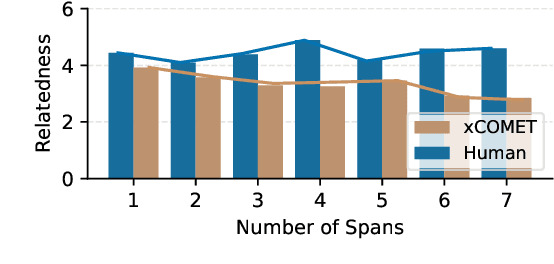Beatriz Silva
xTower: A Multilingual LLM for Explaining and Correcting Translation Errors
Jun 27, 2024



Abstract:While machine translation (MT) systems are achieving increasingly strong performance on benchmarks, they often produce translations with errors and anomalies. Understanding these errors can potentially help improve the translation quality and user experience. This paper introduces xTower, an open large language model (LLM) built on top of TowerBase designed to provide free-text explanations for translation errors in order to guide the generation of a corrected translation. The quality of the generated explanations by xTower are assessed via both intrinsic and extrinsic evaluation. We ask expert translators to evaluate the quality of the explanations across two dimensions: relatedness towards the error span being explained and helpfulness in error understanding and improving translation quality. Extrinsically, we test xTower across various experimental setups in generating translation corrections, demonstrating significant improvements in translation quality. Our findings highlight xTower's potential towards not only producing plausible and helpful explanations of automatic translations, but also leveraging them to suggest corrected translations.
Encoder-Decoder Architectures for Clinically Relevant Coronary Artery Segmentation
Jun 21, 2021



Abstract:Coronary X-ray angiography is a crucial clinical procedure for the diagnosis and treatment of coronary artery disease, which accounts for roughly 16% of global deaths every year. However, the images acquired in these procedures have low resolution and poor contrast, making lesion detection and assessment challenging. Accurate coronary artery segmentation not only helps mitigate these problems, but also allows the extraction of relevant anatomical features for further analysis by quantitative methods. Although automated segmentation of coronary arteries has been proposed before, previous approaches have used non-optimal segmentation criteria, leading to less useful results. Most methods either segment only the major vessel, discarding important information from the remaining ones, or segment the whole coronary tree based mostly on contrast information, producing a noisy output that includes vessels that are not relevant for diagnosis. We adopt a better-suited clinical criterion and segment vessels according to their clinical relevance. Additionally, we simultaneously perform catheter segmentation, which may be useful for diagnosis due to the scale factor provided by the catheter's known diameter, and is a task that has not yet been performed with good results. To derive the optimal approach, we conducted an extensive comparative study of encoder-decoder architectures trained on a combination of focal loss and a variant of generalized dice loss. Based on the EfficientNet and the UNet++ architectures, we propose a line of efficient and high-performance segmentation models using a new decoder architecture, the EfficientUNet++, whose best-performing version achieved average dice scores of 0.8904 and 0.7526 for the artery and catheter classes, respectively, and an average generalized dice score of 0.9234.
 Add to Chrome
Add to Chrome Add to Firefox
Add to Firefox Add to Edge
Add to Edge